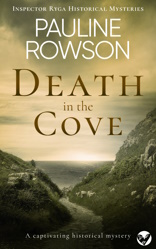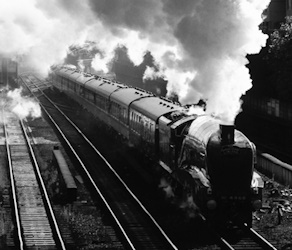
The 1950s was a time so vastly different to today in a number of ways - policing, social and moral codes, transport and housing. Over the years we have seen a huge swell in building development in the UK, particularly in England, with urban sprawls swallowing up vast tracts of countryside, with new towns springing up and the dramatic change in our town centres. And I am sure this is reflected in other countries.
With regards to transport there has been an explosion in car ownership, the demise of trams, trolley buses and steam trains and the decimation of the railways with the infamous Beeching cuts in the 1960s in the UK, isolating many people and destroying commerce for small town centres and villages.
My job as a writer of historical crime fiction, with my Inspector Ryga coastal murder mysteries set in the 1950s, is to recreate that world, making it as realistic as possible for the reader, allowing him or her to step back in time.
 Inspector Ryga does not have a car, he wouldn’t have in 1950s England, (although Eva Paisley, a professional photographer whom Ryga teams up with does). Ryga, who is a Scotland Yard detective is sent out to investigate coastal crimes and, as was usual in that era, he is despatched by train at a moment’s notice to assist a local constabulary with a complex and baffling murder case. There he might be fortunate enough to utilise the station’s vehicle, usually an Inspector’s own car for which a petrol allowance was paid, otherwise it would be on the bus or train for Ryga.
Inspector Ryga does not have a car, he wouldn’t have in 1950s England, (although Eva Paisley, a professional photographer whom Ryga teams up with does). Ryga, who is a Scotland Yard detective is sent out to investigate coastal crimes and, as was usual in that era, he is despatched by train at a moment’s notice to assist a local constabulary with a complex and baffling murder case. There he might be fortunate enough to utilise the station’s vehicle, usually an Inspector’s own car for which a petrol allowance was paid, otherwise it would be on the bus or train for Ryga.
 In the novels I send him to the Royal Island of Portland, Dorset in Death in the Cove; to the port of Newhaven in Death in the Harbour, to the small fishing port of Brixham, Devon in Death in the Nets and to Hythe in Kent in Death in the Dunes. I’m currently working on number five in the series which is set in Penzance, Cornwall.
In the novels I send him to the Royal Island of Portland, Dorset in Death in the Cove; to the port of Newhaven in Death in the Harbour, to the small fishing port of Brixham, Devon in Death in the Nets and to Hythe in Kent in Death in the Dunes. I’m currently working on number five in the series which is set in Penzance, Cornwall.
I therefore need to know the train and bus times not simply from London but in the locations where Ryga is engaged on his investigations. For this I turn to an amazing website https://timetableworld.com where I can gain access to a vast number of transport timetables of that era. It makes fascinating reading and I find myself absorbed with working out how Ryga gets from A to B by train and bus (and in future novels by ferry). So much so that I’m convinced I shall turn into a railway buff!
Once having got Ryga to his destination he needs to interview local people and view the crime scene/s and as I use real locations (although I do create fictitious street names on occasion) I need maps of the locale. For this I visit the wonderful National Library of Scotland website of Ordnance Survey maps. Often the map I require won't be bang on 1950 or 1951 but most maps were updated in the mid to late 1940s which is near enough, major re-development more generally having taken place in the 1960s onward.
I will pull off copies of the areas chosen and pin them on to a large board which will stay with me as I write the novels while gleaning further location research from historical based websites with wonderful photographs and personal accounts from those who were raised and lived in the locale.
I also like to check on the weather for that month and day if possible in 1950 and 1951 – was it foggy, windy, wet, unusually cold or hot? This does not have to be spot on but I find checking this with the various online resources of blogs, digitalised newspaper reports and the Met offices own reports can give me a new idea for the plot line or a twist in the story.
The internet for all its drawbacks has great advantages, it makes my research a much easier task and for that I’m grateful.
"For lovers of mysteries without the gory details. The ending was a twist I didn't see coming." Amazon
" Inspector Ryga is an engaging lead character, shaped by his war-time experiences to be a sensitive, astute detective. The interesting setting of post-war Britain is soaked in atmosphere and I loved the complex, twisting plot. Historical crime-writing at its very best." Amazon
Available on Amazon Kindle, Kindle Unlimited and paperback. The first two Inspwector Ryga mysteries are also available as audio books.
Pauline Rowson lives on the South Coast of England and is the best selling author of many crime novels, published by Joffe Books. Her popular crime novels include the DI Andy Horton Solent Murder Mystery series, the Art Marvik mystery thrillers and the 1950s set Inspector Ryga mysteries. Subscribe to her newsletter for all the latest books news.